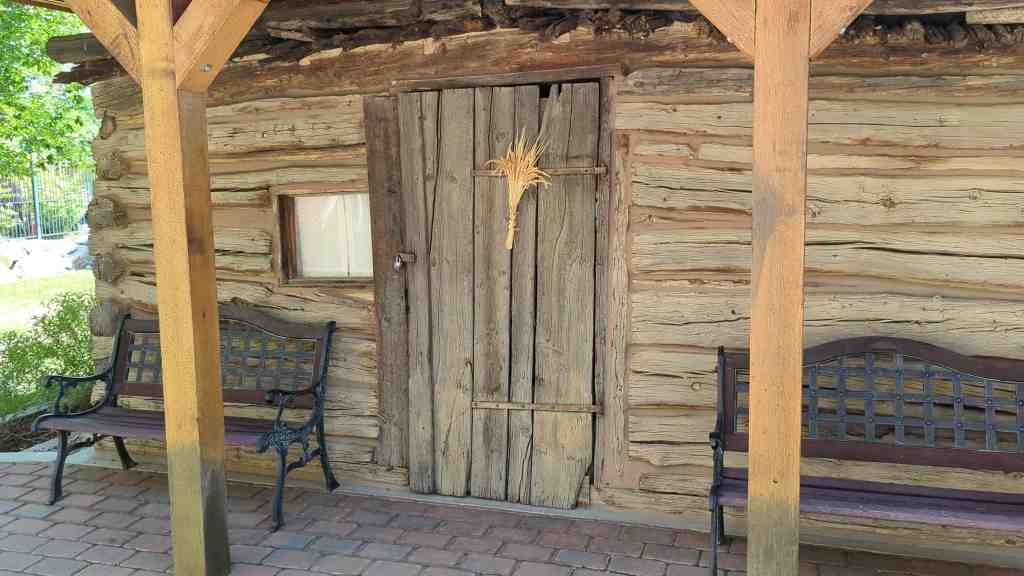Tags

The Miles Goodyear Cabin is located outside the Weber County Daughters of Utah Pioneers Museum at 2104 Lincoln Avenue in Ogden, Utah. There are several historic markers that talk about it:
U.P.T.L.A. Marker #41 says:
This cabin, built about 1841 by Miles Goodyear, as far as known the first permanent house built in Utah, stood near the junction of the Ogden and Weber Rivers. In 1848 it was sold to Captain James Brown of the Mormon Battalion with a Spanish land grant covering all of Weber County. It was preserved by Minerva Stone Shaw and by her presented to the Daughters of the Utah Pioneers, Weber County Chapter, who placed it on its present site.
D.U.P. Marker #484 says:
Miles Morris Goodyear built this cabin on the lower Weber River as a way station and trading post. The cabin, along with other buildings became Fort Buenaventura meaning good venture. It was the first permanent settlement in the Utah Territory. Miles Goodyear (1817-1849) had traveled as far as Fort Hall in 1836 with Dr. Marcus Whitman’s party of Methodist Missionaries. Goodyear was a trapper, prospector and trader. His Indian wife Pomona was the daughter of Ute chief Peet-teet-neet. The couple had two children, William Miles and Mary Eliza.
Mormon Battalion Captain James Brown and Mary Black Brown bought Fort Buenaventura and all of Weber County for $1,950 in gold. Mary Brown made the cabin home for her family and made 1,000 pounds of cheese during the first year.
The Browns sold the cabin to Amos P. and Minerva Leontine Jones Stone. The Stone family lived in the cabin for a time, eventually using it as a blacksmith shop. A daughter, Minerva Pease Stone Shaw, in 1926 presented the cabin to Weber County Daughters of Utah Pioneers for preservation. It has been moved seven times, ultimately being placed at this site. In 1994 it was disassembled for preservation of the logs and reassembled in 1995 at this location to benefit posterity.
The Ogden City Landmarks Commission plaque says:
Miles Goodyear came west as a venturesome young man with the Whitman- Spaulding Expedition of 1836. He married a daughter of the Ute Chief, Pe-teet-neet, and located his stockade and cabin on the Weber River. This post became a stop-over and replenishment station for California-bound emigrants. Goodyear called his place Fort Buenaventura.
The cabin was built of sawed cottonwood logs in 1845 by Goodyear. Its dimensions are 14’4″x17’9″. The original floors were dirt. As the foundation logs sat on the ground, they rotted away and have been replaced. In addition, some of the lumber in the door and the windows was sawed after 1847.
Originally located on the Weber River two miles above the Ogden River confluence, the cabin has been moved several times. In 1928 it was donated to the Daughters of the Utah Pioneers.

























The cabin was added to the National Historic Register (#71000866) on February 24, 1971.
The earliest permanent white settlers in Utah were trappers and traders. In the Miles Goodyear cabin the story is told of the transition from trap- per and trader to settler. Goodyear came west as a venturesome young man with the Whitman-Spaulding Expedition of 1836. At Fort Hall on the Snake River in present-day Idaho, he left the party to become a mountain man.” In time he married a daughter of the Ute Chief, Pe-teet-neet, and located his stockade and cabin on the Weber River. This post became a stop-over and replenishment station for California-bound emigrants. Goodyear called his place Fort Buenaventura.
Goodyear combined his trapping ventures with trading as far afield as California. On July 10, 1847, he met the advance party of the first Mormon emigrants at Bear Lake bottoms, where he talked with O. P. Rockwell, George A. Smith, Erastus Snow, and Norton Jacobs.
The new emigrants soon became interested in Goodyear’s holdings. James Brown saw them in August, 1847. After returning from California with Mormon Battalion payrolls, Brown pursued this interest and was per- mitted to negotiate with Goodyear who sold his properties for $1,950.00. The original claim included about 225 square miles, nearby all of present Weber County.
Brown moved in by March, 1848. The site became known as Brown’s Fort, Brown’s Settlement and, subsequently, Brownsville. The name Ogden was be- stowed officially in 1851.
Only the cabin remains of Goodyear’s Fort Buenaventura. But through it, this important transitional part of American and Utah history can be told.
